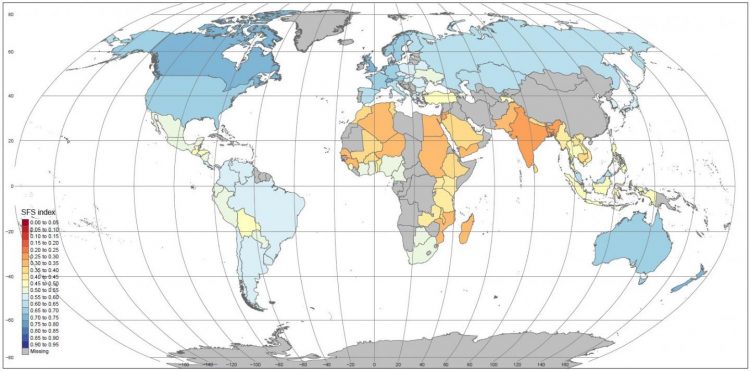Study rates food sustainability country-by-country
Posted: 25 November 2019 | Sam Mehmet (New Food) | No comments yet
A global food system sustainability study has built a map to score the sustainability of food systems country-by-country, including economic and social variables.


Global initiatives are calling for consumers to transform their diets – for their health and the health of the planet – to help make food systems “sustainable.” Researchers at the International Center for Tropical Agriculture (CIAT) have argued that social and economic variables also need to be included if we are to understand exactly how sustainable our food systems are.
The researchers settled on 20 indicators that are available to 97 countries from low-, middle- and high-income regions, and built a global map to rate the sustainability of food systems across the globe. The indicator can be used to track changes in sustainability over time and has the potential to guide policy and action as climate change, rising populations and increased demand for food place unprecedented pressure on global food systems.
“Addressing the question of the (un)sustainability of our food systems is critical as the world is bracing for hard-choice challenges and potentially massive trade-offs around issues related to food quality and food security in the coming decades,” wrote the authors.
Food systems – which refer to the whole web of food production and consumption, from pre-production to food waste – are considered to still be a relatively new area of research. There is said to be little uniformity in terms of indicators used by researchers, governments and international development organisations. The research also aimed to seek standardised terms and methods to help further food systems research.


This map scores the sustainability of food systems country-by-country. The scale goes from blue to red, with blue indicating a high sustainability score. Grey means there is not enough data available to rate the country. Credit: Béné et al., International Center for Tropical Agriculture
The study’s authors sorted the 20 indicators into four dimensions: environment, economic, social, and food and nutrition. The indicators cover a range of factors including greenhouse gas emissions from agriculture, size of the female labour force, fair trade, food price volatility, and food loss and waste.
“This is the first attempt to empirically measure and characterise the sustainability of the food systems worldwide considering not only the dimension food security and nutrition, or environment, but also economic, and social dimensions,” said Camila Bonilla, a co-author at the University of California, Davis.
“The food system is probably the largest employer in the world, so the sustainability of food systems is also about the economic and social contributions of those hundreds of thousands of people and enterprises that are involved in some aspect of the system – from production all the way to food retail and distribution and consumption,” said Christophe Béné, the study’s lead author and senior policy expert at CIAT’s Decision and Policy Analysis (DAPA) research area. “It means that the economic and social dimensions of food system sustainability cannot be ignored.”
“Our research highlights how little is currently known about food systems,” said Béné. “The reason is that national statistical systems, in both high- and lower-income countries, are collecting only a small portion of the information that is needed to build a comprehensive picture of the whole system.”
In the 83 documents used in their literature review, the researchers found 192 different indicators, many of which have some level of overlap but not all of which were directly comparable across countries.
“This research represents a critical step forward in understanding the relationship between the structure and function of food systems and their sustainability,” said Steven Prager, a co-author senior scientist at CIAT. “The global food system is really a set of interconnected subsystems and this work offers one of the most systematic attempts to date to unpack food system dynamics, from farm to fork to policy.”
Related topics
Related organisations
International Center for Tropical Agriculture (CIAT), University of California-Davis









